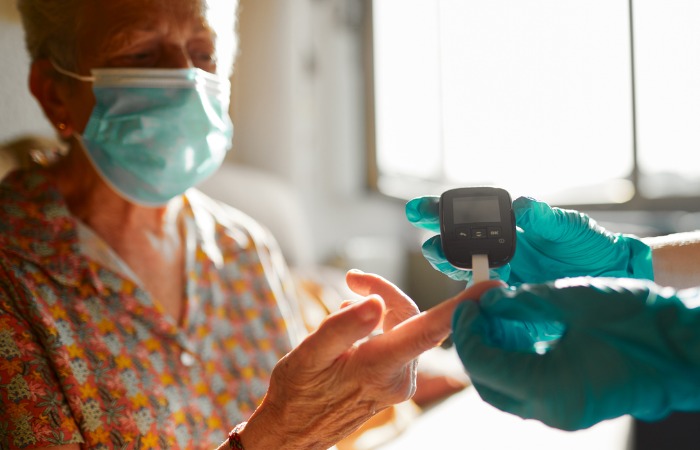
COVID-19 has been especially difficult for hospital patients with diabetes and other chronic conditions, such as COPD and heart disease. Along with older adults and people suffering from obesity, these patients often face greater challenges and worse outcomes with COVID-19, including a higher death rate. They account for significant numbers of inpatients – studies show that about 25% of people hospitalized with COVID-19 also have diabetes.
UAB Medicine’s comprehensive Inpatient Diabetes & Glycemic Management Program developed an Inpatient Diabetes & Glycemic Management Service (IGMS) to better manage patients with diabetes and/or hyperglycemia while they’re in the hospital, and the team has played an important role in caring for patients with COVID-19. Treatment for the virus often includes the drug dexamethasone, a corticosteroid that increases insulin resistance and can cause hyperglycemia (high levels of sugar, or glucose, in the blood). This makes it even harder to manage patients with diabetes, while emphasizing the role of endocrinology in delivering COVID-19 care.
The Inpatient Diabetes & Glycemic Management Program is a multidisciplinary effort involving physicians, nurse practitioners, and trainees from the UAB Medicine Division of Endocrinology, Diabetes, and Metabolism. Members of the IGMS team include Lindsey Harris, DNP; Ashley Petty, DNP; Cassandra Ridgel, DNP; Donna Stevens, DNP (lead NP); and Lenora Wade, DNP. The supervising endocrine faculty members are Carlos Arguello, MD; Deepti Bahl, MD; Anish Patel, MD; Krishmita Siwakoti, MD; Amy Warriner, MD; Henry Zelada, MD, and Division Director Fernando Ovalle, MD.
The IGMS team focuses on helping manage patients who:
- Have hyperglycemia and are on tube feedings or other types of nutrition not delivered by mouth
- Are using a patient-controlled insulin pump
- Have steroid-induced hyperglycemia
- Have type 1 diabetes
- Are taking U500 insulin for glycemic management
- Have cases that are difficult to control
- Have significant hyperglycemia or hypoglycemia
- Need assistance with their home regimen for diabetes management
Even after being discharged from the hospital, patients with diabetes have immediate access to specialized care from UAB Medicine. Their follow-up care is provided by another critical component of the Inpatient Diabetes & Glycemic Management Program – the Diabetes Bridge Clinic, until they can be seen by their primary care physician – or by the PATH (Providing Access To Healthcare) Clinic, which serves uninsured patients. The use of online telehealth services grew rapidly in response to COVID-19, and many Diabetes Bridge Clinic patients now prefer the convenience of receiving post-discharge care remotely.
Volume Grew in 2020
In 2020, UAB Medicine saw major growth in serving patients with diabetes. The number of hospital encounters involving the IGMS team rose from 728 in December 2019 to 1,170 in December 2020. For the same period, the Diabetes Bridge Clinic grew a staggering 319%, from 21 visits to 88, and many of those were UAB eMedicine telehealth visits.
To further help improve the outcome of patients with diabetes and hyperglycemia, and to help us train the next generation of diabetes specialists, the Inpatient Diabetes & Glycemic Management Program created another inpatient glycemic management service known as the Fellows Inpatient Glycemic Service, or FIGS. This involved establishing a team of two endocrinology fellows, working under a supervising endocrine faculty member and in coordination with the IGMS team of five nurse practitioners. It is part of the broader Inpatient Diabetes & Glycemic Management Program, which is a key component of the Division of Endocrinology, Diabetes, and Metabolism within the UAB Department of Medicine The IGMS and FIGS teams function as one service, covering UAB Hospital and UAB Hospital-Highlands, and they continue to expand their reach and refine their mission of improving patient blood glucose levels across multiple service lines.
“The efforts of our Inpatient Diabetes & Glycemic Management Program have led to large and clinically significant improvements in glycemic control and patient outcomes,” Dr. Ovalle says. “There has been an overall decrease in glycemic variability and acute glycemic crisis, including reductions in severe hypoglycemia (<40) of 68% and reductions in severe hyperglycemia (>500) of 63%. Moreover, we recently analyzed the outcomes of patients with diabetes and stress hyperglycemia hospitalized at UAB Hospital before and after the implementation of our program, and we have seen a significant reduction in mortality compared to our baseline. Furthermore, the relative risks of mortality and sepsis among those with diabetes and those without diabetes have fallen even more. Stay tuned, as I plan on presenting the complete results of our data analysis soon.”
To order an IGMS consult in IMPACT, select “Consult to Diabetes/Glycemic Management Team”, and the provider covering your area will see the patient. Automated consults are generated for hyperglycemia/hypoglycemia based on documented glucose readings. For post-discharge patients, providers should choose “Follow-Up Diabetes Bridge Clinic” in IMPACT; uninsured patients should be referred to the PATH Clinic.
